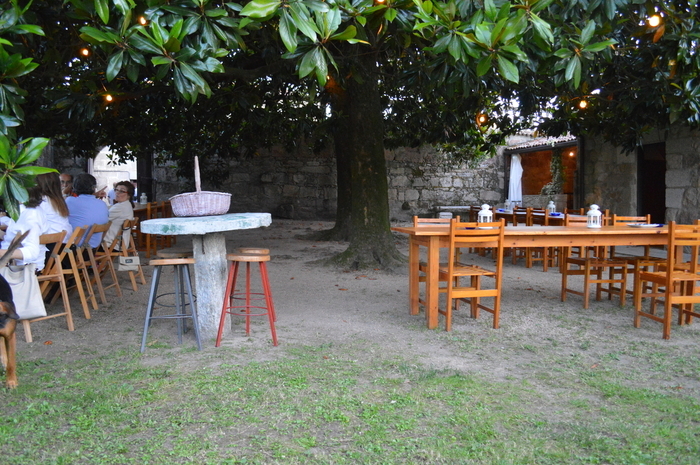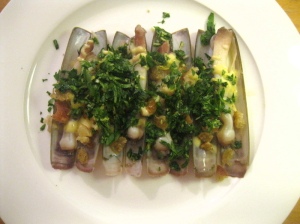
Pintxo-pote is a Basque institution. A selection of bars offer a drink and a pintxo for a small fixed price, usually €2, one night each week. In San Sebastián, the main pintxo-pote scene is on Thursday nights in Gros. The hub is around Plaza Cataluña, Bermingham Kalea, San Frantzisko Kalea and Zabaleta Kalea.It starts at 19:00 and goes on until around 23:00, or until the food runs out, whichever happens first.
Most bars have signs outside saying they offer pintxo-pote, and some have signs saying they very definitely do not. You can usually tell which is which anyway by the crowds and debris outside. These are not the high-end basque pintxos that tourists elbow each other for in the Old Town, but there are some pretty tasty things on offer. The pintxos are lined on the counter of the bar ready to go. The drink on offer is generally wine, beer or cider.
I have zero photos of our pintxo-pote crawl. Trying to take anything close to a half-decent photo holding a flimsy plastic plate and being jostled by surfers and students is tricky, but here is a round-up of our pintxo-pote experience.
The first thing to be aware of is that the wine on offer is usually pretty disgusting. Sadly, txacoli is rarely part of the deal. The cider and beer, on the other hand, were good everywhere we tried them. Basque cider is light, slightly effervescent and crisp. Sticking with beer and cider is also a smart idea if you’re planning to try a lot of places, and don’t like waking up the next day in a bush with croquette crumbs across your cheeks and grease-smeared hands.
We started in La Plata, just off Plaza Cataluña. The options here were pretty good, and we settled on a squid ink croquette, and some sort of delicious chewy pastry filled with melted cheese that looked a little like a doughnut. This was a stalwart of pintxo-pote spreads as it turned out. They tend towards the stodgier end of things, presumably to soak up all the alcohol. Next up was Bar Mendi on San Frantzisko Kalea which offered the standard bread pintxos, as well as small plates of paella, patatas bravas and ensaladilla rusa. We went for a plate of bravas, and a pintxo with ham, goats cheese and crispy onion. We then moved on to Bora Gerri, on Kalea Bermingham. This had a selection of deep fried things like croquettes and prawns on skewers, as well as some bread tapas, so we went for three prawns on a skewer, and some txistorra sausage on bread.
At this point we needed a break and a sit-down, because unlike most of the crowd, we are not in our twenties anymore. The streets had become a sea of discarded plastic plates and cups, the pavements filled with inebriated students smoking a seemingly endless amount of roll-ups. Fortunately, we spotted Essencia wine bar on Zabaleta Kallea, a glorious place with a giant list of wines by the glass, and, unusually for San Sebastian, a great sherry list too. We decided to go for one more pintxo-pote, which ended up being a fairly lacklustre empanadilla at Bar Labrit opposite, before calling it a night.
Pintxo-pote offerings do not match the kind of gourmet pintxos you get in the old town, but this is the Basque Country, so they are still way better than what you should be able to get for this price. San Sebastián can be a pricey place, but a night out and a meal for €10 is an offer that can’t be missed, and an experience you won’t get in other regions of Spain.






























